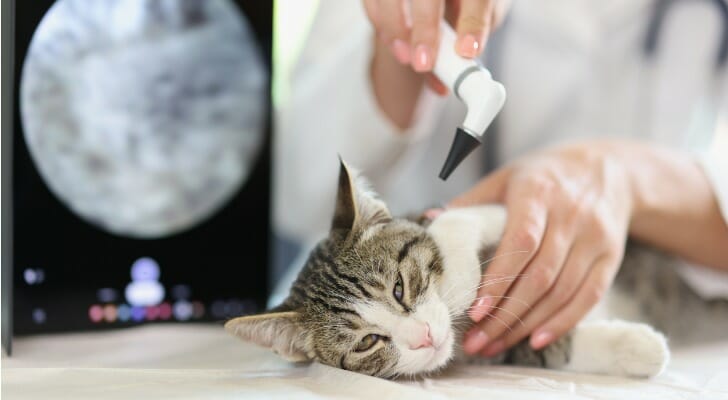Estimates vary, but Americans aspent between $110 billion and nearly $125 billion on their pets in 2021. By 2030 that figure will have jumped to $275 billion, according to Morgan Stanley. The largest percentage went towards food. But pet owners shelled out approximately $34 billion just for veterinary care and associated products, according to the American Pet Products Association. Purchasing pet insurance can offset some of the costs. But you need to make sure it’s really worth it before you sign on the dotted line. Consider working with a financial advisor to make sure your pet expenditures are in line with your overall budget.
How It Works
Pet insurance works similar to any other type of insurance policy, with some slight differences. You buy a policy for the coverage amount you want and pay a monthly premium to the insurance company. Premiums are generally based on your dog’s breed, age and health status. Your deductible is set at the amount you choose and can be applied yearly or on a per-incident basis.
When you take your pet to the vet, you pay all the costs of care up front. To get reimbursed, you have to file a claim form with the insurance company and provide them with copies of your receipts. When you buy your policy, you can choose what percentage of costs you want to be reimbursed for, up to a maximum of 90 percent. Depending on the insurer you choose, there may be a waiting period before you can begin filing claims for treatment.
What It Covers

In 2021 nearly 4 million pets were insured. The types of treatment that pet insurance covers varies widely based on the policy. For example, Trupanion covers up to 90% of the costs of vet care if your pet is sick or injured. This includes things like surgery, hospitalization, lab tests, medications, prosthetic devices and medical care received at emergency clinics. If your pet needs routine medical care, preventive care or treatment for a pre-existing condition, the policy won’t cover any of those costs.
Some policies only cover standard medical treatments but some will also pay for alternative treatments, such as acupuncture, chiropractic visits, stem cell therapy and hydrotherapy. Coverage may or may not be available for things like grooming and dental care. If your pet has a predisposition for a particularly hereditary condition, you may be able to get coverage but you’ll likely end up paying more for your policy. Some insurers won’t cover working dogs, like police or therapy dogs, while others require you to pay higher premiums if your pet hasn’t been spayed or neutered.
How the Costs Breakdown
Just as your coverage options vary, so do premiums. They will vary according to three categories: the amount of annual coverage; the percentage of the total bill the insurer will pay; and the size of the deductible.
For example, ASPCA Pet Insurance offers a policy on a Beagle mix with five annual limits, with the lowest being $3,000 and the highest being $10,000. The reimbursement levels are 70%, 80% and 90%. Annual deductibles are $100, $250 or $500 per pet. Choosing minimum levels, including a high deductible, for all three categories results in monthly premiums of $16.77. Choosing the maximum levels for all three categories results in monthly premiums of $61.30. Premium rates are slightly lower for cats compared to dogs.
Is It Worth It?

In terms of whether it’s actually a wise investment to purchase pet insurance, it really depends on how healthy your pet is and how much you’re willing to spend on their medical care. The American Pet Products Association estimates that the average annual cost of pet care in 2021 for dogs is about $1,391 and $1,149 for cats. With the cost of veterinary care expected to rise, having a pet insurance policy in place could soften the blow if your pet needs expensive medical treatment.
On the other hand, pet insurance may be a waste of money if your pet’s relatively healthy and you’re only paying for routine medical care. There are also lots of options for getting low-cost pet care which are worth looking into. For example, you may be able to get discounts on medications or routine visits through your local animal shelter. Many retail pet stores also offer in-house grooming and preventive care, which can you save you money on things like heartworm medication and vaccinations.
One of the easiest ways to save money on your pet’s medical expenses is to take good care of them. Doing things as simple as choosing the right foods and making sure they get plenty of exercise can go a long way towards improving their health. Building up a savings account reserved specifically for your pet care costs can give you the financial buffer you need if an illness or emergency hits.
The Bottom Line
The cost of healthcare insurance for your pet has been climbing rapidly in recent years and is expected to continue rising. The size of the premiums depend on the pet’s breed, age, location and type of coverage chosen. On average, monthly premiums can range from less than $20 to $70 or more. The upshot is pet owners have many choices and a wide range of monthly premiums. One way to keep premiums lower is to take good care of your pet. Dogs tend to be somewhat more expensive than cats.
Tips on Personal Finance
- A financial advisor can help you set a budget for buying, caring for and – possibly – insuring your pet. If you don’t have a financial advisor yet, finding one doesn’t have to be hard. SmartAsset’s free tool matches you with up to three vetted financial advisors who serve your area, and you can interview your advisor matches at no cost to decide which one is right for you. If you’re ready to find an advisor who can help you achieve your financial goals, get started now.
- Check out SmartAsset’s primer on healthcare for retirees.
Photo Credit: Photo credit: ©iStock.com/AndreyPopov, ©iStock.com/megaflopp, ©iStock.com/Wavebreakmedia
